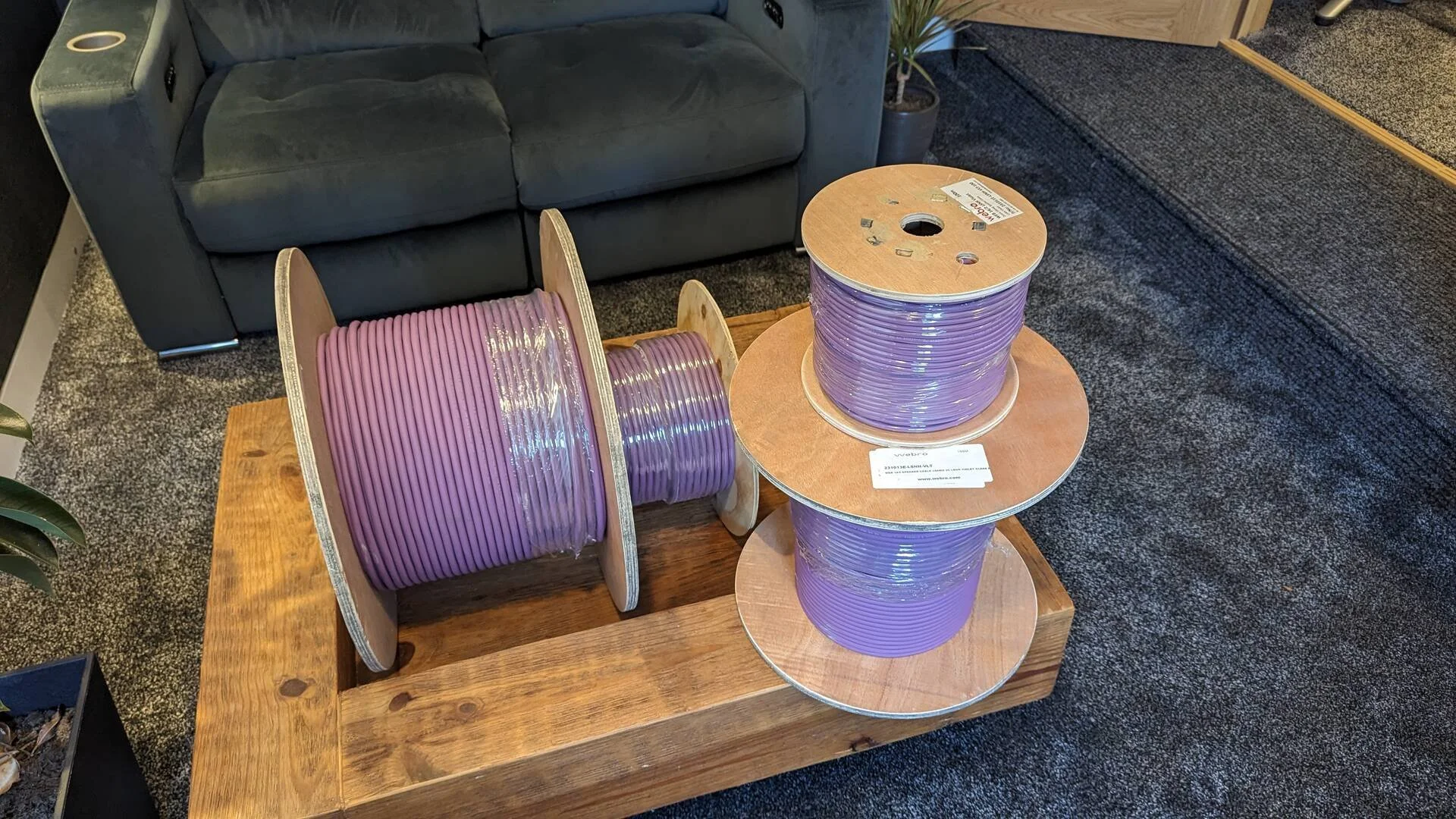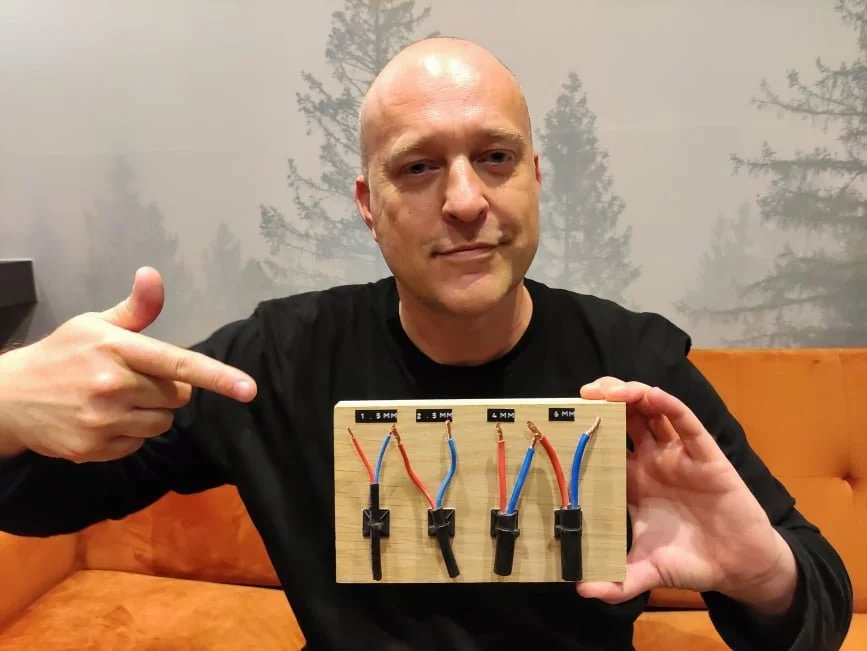
Choosing the Right Speaker Cable for Your Cinema Room
Speaker cable can be one of the most overlooked components in achieving cinema-quality sound at home it is also probably the simplest way to ensure great sound.
Choosing the Right Speaker Cable for Your Home Cinema Room
When designing a home cinema room, most people focus on the big-ticket items — the projector, the screen, the speakers, and the seating. But one of the most overlooked components in achieving true cinema-quality sound at home is also one of the simplest: the speaker cable.
The wrong cable can reduce performance, introduce resistance, and rob your system of the impact and detail you’ve invested in. The right cable, correctly specified for the distance and power handling of your system, ensures you hear every whisper of dialogue, every subtle detail in the soundtrack, and every explosion with full weight and clarity.
In this guide, we’ll explore:
✅Why cable gauge (thickness) matters in home cinema installations.
✅ The differences between 16/2, 14/2, and 12/2 cable sizes and when to use each.
✅ Why pure copper cables outperform aluminium-clad copper (CCA).
✅ How cable length and resistance affect sound quality.
✅ Practical recommendations for wiring your cinema room for maximum performance and reliability.
Why Speaker Cable Gauge Matters
Speaker cables are responsible for carrying the electrical signal from your amplifier or AV receiver to your speakers. This signal is relatively high current compared to line-level audio, and it needs to travel without significant resistance.
Cable gauge refers to the thickness of the conductor inside the wire. In the UK and US, this is typically measured in AWG (American Wire Gauge) — the smaller the number, the thicker the cable.
✅ 16 AWG (16/2) – Thinner cable, good for short runs and low to medium power speakers.
✅ 14 AWG (14/2) – A thicker cable, suitable for medium runs and higher-powered systems.
✅ 12 AWG (12/2) – A heavy-duty cable, ideal for long runs, subwoofers, or high-performance installations.
The “/2” simply means two conductors (positive and negative), which is standard for most speaker wiring.
The thicker the wire, the lower its resistance, which means more of the amplifier’s power reaches the speaker instead of being lost as heat. If the cable is too thin for the run length or power, you may experience reduced dynamics, weaker bass, or even audible distortion at high volumes.
Resistance, Distance and Performance
The resistance of a cable is determined by three factors:
✅ The material (copper vs aluminium).
✅ The thickness (gauge).
✅ The length of the run.
Longer runs increase resistance. A thin 16 AWG cable may be perfectly fine for a 2-metre run to bookshelf speakers, but stretch that same cable over 15 metres to a rear surround speaker, and the losses become audible.
Here’s a practical guideline for maximum recommended cable lengths using pure copper wire:
✅ 16 AWG – Up to 10–12 metres (ideal for short speaker runs, surrounds, and low-power systems).
✅ 14 AWG – Up to 15–20 metres (great all-round choice for mid-size cinema rooms).
✅ 12 AWG – 20+ metres (best for long runs, subwoofers, and very high-power speakers).
If you’re wiring a Dolby Atmos system with ceiling speakers, you’ll often be running cables through walls and ceilings over considerable distances — making 14 AWG or 12 AWG the smarter choice.
Copper vs Aluminium-Clad Copper (CCA)
Not all cables are created equal. Many budget-friendly cables use aluminium conductors clad in a thin layer of copper (CCA). While cheaper, these cables have around 60% of the conductivity of pure copper, meaning they suffer more resistance for the same gauge size.
This has real-world consequences:
✅ Bass can sound weaker and less defined.
✅ Amplifiers work harder to push current through the higher-resistance wire.
✅ High-frequency detail may be dulled over long runs.
✅ Over time, aluminium is also more prone to oxidation, reducing long-term reliability.
For home cinema installations, where clarity, punch, and detail matter, we strongly recommend using OFC (Oxygen-Free Copper) cable. Pure copper maintains conductivity, resists corrosion, and provides consistent performance for decades.
Choosing Between 16/2, 14/2 and 12/2
So, which cable size should you use for your home cinema? It depends on room size, speaker layout, and run length.
16/2 Cable – Compact and Cost-Effective
✅ Best for short runs under 10 metres.
✅ Ideal for bookshelf or surround speakers in small to medium rooms.
✅ Flexible and easier to pull through conduit or tight spaces.
✅ Not recommended for long distances or very high-powered systems.
14/2 Cable – The All-Rounder
✅ Works for most medium-sized cinema rooms.
✅ Handles runs up to around 15–20 metres without issue.
✅ Provides a balance of flexibility, performance, and cost.
✅ Excellent choice for in-wall and in-ceiling speakers in Dolby Atmos setups.
12/2 Cable – Heavy-Duty Performance
✅ Best for long runs or very high-power speakers.
✅ Excellent for subwoofers, where low-frequency energy demands thicker conductors.
✅ Stiffer and slightly harder to install, but worth it for reliability over distance.
✅ The premium choice for reference-grade cinema rooms.
Installation Considerations
When wiring a cinema room, it’s not just about choosing the right gauge — it’s also about installation best practice:
✅ Future-Proofing – Always run slightly thicker cable than you think you’ll need. It ensures flexibility for upgrades later.
✅ In-Wall Rated Cable – Use CL2 or CL3 rated cable for in-wall installations to meet building regulations and fire safety standards.
✅ Label Everything – With multiple channels (5.1, 7.1, Atmos), labelling cables avoids confusion during installation.
✅ Cable Routing – Keep speaker wires away from mains cables to reduce potential interference.
✅Use Conduit Where Possible – This allows easy replacement or upgrading in the future.
How Cable Choice Affects Sound
It’s tempting to dismiss speaker cable as “all the same,” but in reality, the wrong choice can audibly degrade performance.
✅ Thin or undersized cable may roll off bass, making explosions and soundtracks feel weaker.
✅ High resistance cable can dull high-frequency detail, reducing the sense of space and clarity.
✅ Long runs with the wrong gauge may cause imbalances, with rear or Atmos speakers sounding quieter or less dynamic than fronts.
By using the correct gauge and pure copper, you ensure that every watt of amplifier power translates into clean, powerful, and accurate sound at your listening position.
Recommended Speaker Cable Setup for Home Cinema
For most 5.1 or 7.1 setups in a medium-sized room:
✅ 14/2 OFC cable is the safe, all-purpose choice.
For larger rooms, subwoofers, or Atmos installations:
✅ Use 12/2 OFC cable for longer runs and bass channels.
For short bookshelf or surround runs under 8–10 metres:
✅ 16/2 OFC cable will usually suffice.
Always choose OFC pure copper over aluminium-clad alternatives.
Conclusion
In a home cinema, sound is half the experience — and your speaker cable plays a bigger role than most people realise. By selecting the right cable gauge for the distance, and ensuring you use high-quality pure copper conductors, you guarantee that your speakers perform at their absolute best.
At Cinema at Home, we’ve installed over 100 bespoke cinema rooms and every one of them uses carefully specified cabling as part of a complete acoustic and design plan. From subwoofers that shake the floor to the crisp detail of dialogue and Atmos effects overhead, the right cable ensures every seat in your room gets the full cinematic experience.
If you’re planning your own cinema build, don’t overlook the details — because in home cinema design, details make the difference.
📞 Want to talk to experts about your home cinema project? Contact us today on 07478 771026 and we’ll help you design a system that looks and sounds incredible.
Speaker Cable: Frequently Asked Questions
What gauge speaker cable do I need for a home cinema?
Use 16 AWG up to about 10 metres per run for typical 8-ohm speakers. Step up to 14 AWG for longer runs or 4-ohm speakers. For very long runs over 20 metres, consider 12 AWG. Lower AWG numbers mean thicker cable.
Does cable length need to match for left and right speakers?
Yes. Keep stereo pairs the same length to keep resistance and timing identical. Match within a few centimetres.
OFC vs CCA. Which should I choose?
Choose Oxygen-Free Copper (OFC). Avoid Copper-Clad Aluminium (CCA) because it has higher resistance and can run hotter at the same gauge.
Stranded or solid core?
Use stranded copper. It is flexible, durable, and easier to route. Solid core is stiff and not ideal for cinema installations.
Do I need shielded speaker cable?
Usually no. Speaker-level signals are high enough to resist interference. Good routing and separation from mains are more important.
How far should I keep speaker cable from mains power?
Keep at least 150 mm separation where cables run in parallel. If they must cross, do so at 90 degrees. Use separate conduits or containment if possible.
Are banana plugs better than bare wire?
Banana plugs give a secure, repeatable connection and make rack work faster. Bare wire can oxidise and loosen over time.
Can I run speaker cable in walls and ceilings in the UK?
Yes. Use LSZH-jacketed cable that meets CPR requirements. Follow BS 7671 routing practices and fire-stopping. Use conduit where future upgrades are likely. Consult a qualified electrician for compliance.
What is polarity and why does it matter?
Polarity is the positive and negative orientation of the cable. Keep it consistent on every run. If polarity is reversed, imaging, bass, and dialogue clarity suffer.
Is bi-wiring worth it?
It rarely gives a measurable improvement in modern systems. Bi-amping with separate amplifier channels can help in some designs, but room acoustics and placement usually deliver larger gains.
Can cable quality change the sound?
Within sensible specs, the big wins come from correct gauge, proper terminations, tidy routing, and equal lengths. Exotic materials bring diminishing returns in most cinemas.
How long can a speaker run be before performance drops?
There is no fixed limit, but resistance rises with length. Over 15–20 metres, move to 14 AWG or 12 AWG and verify performance with measurements.




